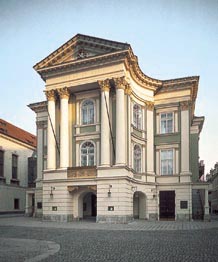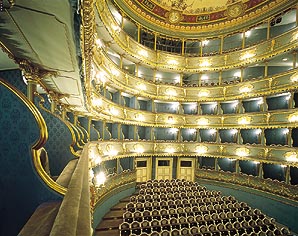 |
|
|
| |
||
| Classified Ads |
| Prague Compass |
|
|
FEATURE
STORY • NIGHTLIFE
• ART+CULTURE • FOOD+DRINK
• TRAVEL
• STYLE

Theater
of Enlightenment
 According
to the BBC, scientists have proved that listening to Mozart makes you
more intelligent. If so, music lovers worldwide owe a debt of gratitude
to the Czech lands, specifically to Prague, and in particular to the Stavovské
(Estates) Theater. For it was here that Mozart the composer also served
as Mozart the conductor when he delivered the world premiere of his opera
Don Giovanni from the Stavovské's stage, dedicating the work to
the people of Prague. He went on to appear at the theater on frequent
occasions, also conducting the premiere of his opera La Clemenza di Tito
(The Clemency of Titus), which opened in 1791, on the day of the coronation
of the new sovereign of the Kingdom of Bohemia, Leopold II.
According
to the BBC, scientists have proved that listening to Mozart makes you
more intelligent. If so, music lovers worldwide owe a debt of gratitude
to the Czech lands, specifically to Prague, and in particular to the Stavovské
(Estates) Theater. For it was here that Mozart the composer also served
as Mozart the conductor when he delivered the world premiere of his opera
Don Giovanni from the Stavovské's stage, dedicating the work to
the people of Prague. He went on to appear at the theater on frequent
occasions, also conducting the premiere of his opera La Clemenza di Tito
(The Clemency of Titus), which opened in 1791, on the day of the coronation
of the new sovereign of the Kingdom of Bohemia, Leopold II.
When the theater opened in 1783, the following words were inscribed in Latin above the main entranceway: Patriae et Musis, or "Music and the Homeland", and they remain there to this day. The theater's reason for being was clear from the outset. The Stavovské - funded by the Bohemian aristocrat, Count Nostitz - was created at the height of the Enlightenment, a wave of idealism that was flooding through Europe during that period. The architectural style of the theatre embodied the eighteenth century's era of High Baroque and its stage seemed to be awaiting the arrival of the young Austrian genius whose name was already well known throughout the continent.
Mozart, now somewhat a patron saint of Prague's splendor and mystique, took to the city like a swan settling on the river Vltava. Although Miloš Forman's classic movie Amadeus portrayed a boisterous, boozy, womanizing genius, other accounts describe him as an ordinary family man going about a quiet, albeit brief, life. In fact it was the ecstatic response from Prague's theater-goers to his opera The Marriage of Figaro that first drew Mozart to the city in 1787, having received a lukewarm reception in Vienna, and he established a great rapport with the Czech musicians with whom he collaborated.
Count Nostitz's original plan was to stage performances in German, the region's principal language under the Austro-Hungarian Empire, and Italian, the language in which operas tended to be written. Yet, so popular was the theater with the local people that by 1785, only two years after its construction, performances were being presented in Czech and audiences were squeezing excitedly into the auditorium. After Nostitz´s death in 1798 it was purchased by the Czech Estates (or stavy) and renamed the Royal Estates Theater or Královské stavovské divadlo. Performances in Czech were restricted as it was felt that they blemished the Germanic character of the theater. Indeed, Czech intellectuals, fearing the extinction of their native tongue, met regularly at the Malostranská Beseda, now a bar and jazz music venue, located in Malostranské Námestí, to keep the language going.
Despite all this, the affinity the Czechs had always attached to the Stavovské Theater remained strong and in 1834 a play, The Bagpiper of Strakonice, by the popular dramatist Karel Tyl, contained a song known as Kde Domov Muj (Where is My Home), penned by František Škroup, which immediately became a big hit and was taken on by the Czechs as their national anthem, which is still sung on occasions of national importance. In 1862 Czech theater acquired an independent venue, the Prozatimní or "temporary" theater, until the National Theater was built and Czech language performances ceased until 1920. The Czech language was once again banished from the venue in 1939 under the German occupation and the last play to be performed there in July 1939, Jirásek´s Lucerna, was also the first play to be performed after the war in 1945.
Today the National Theater Company presides over
three theaters - Narodní Divadlo, the Stavovské and the
Kolovrat - and is a state institution, funded by the Ministry of Culture,
private sponsors and ticket sales. The company oversees ballet, opera
and drama and maintains its own ensemble of actors, actresses and musicians.
Martin Bonhard, the 31-year-old Secretary General of the National Theatre,
speaks warmly of the theatre's past and present: "The influence of
Mozart on the (Stavovské) theater and its stage is huge, even now.
Performances of his work are only ever held in the Stavovské Theater.
The situation of the theater is extremely healthy." 
The Stavovské, featured extensively throughout Forman's film, is indeed an impressive sight both inside and out. Situated on Ovocný Trh (Fruit Market) it is all icing cake architecture decorated in soft pastel greens and whites, standing at perhaps the very epicenter of the modern city, as if its music and dramatic prose rise from that grand stage, and in concentric circles the songs and words float out to the general population, entertaining and enlightening on a broad scale.
Associated with the very beginnings of Czech professional drama, the Stavovské still performs premieres for contemporary Czech composers of immense talent. Men such as Kryštof Maratka, Petr Kofron and Martin Šmolka regularly stage their work here. Šmolka even managed to conjure up an opera entitled Nagano, so inspired was he by the Czech national ice hockey team's gold medal at the 1998 winter Olympics in the city of the same name. The leading lights of Czech dramatic circles frequently tread the boards, among them Magdalena Kožená, Eva Urbanová and Dagmar Pecková, all superstars in their homeland.
Spread out across five pages in the cultural section of a local magazine a reader can find the names and repertoire of 52 different theaters and opera houses in the city of Prague alone. One for every week of the year, or one theater for every 23,000 people, numbers that reflect the cultural impact and significance attached by the Czech people to their playhouses.
Prior to the period of Enlightenment, music and drama were the sole preserve of the wealthy, with performances taking place in private, stately homes. However, the Czech nation will be forever grateful to the Dušek family who housed the young Wolfgang Amadeus at their villa in Smíchov, now the Bertramka Museum, found on Mozartová Street. When he eventually departed Prague he left behind one of his most beautiful arias, Bella Flamma Mia Addio, written for his host Josefína Dušková, also a singer.
The Enlightenment had targeted the domination of society by a hereditary aristocracy. Society was to be built on common sense and judicial tolerance and the movement provided the framework for civil order in America and France following the revolutions in those two countries. The Czech's own Velvet Revolution in 1989 gave a newfound dramatic license to writers and performers alike - a very recent concept for generations of intellectuals shackled and gagged for years by the hard-line communist authorities. Playwright and ex-President Václav Havel spent four years behind bars for daring to be creative and therefore it was apt that his play The Garden Party was staged at the Stavovské in 1991. This was followed closely by another blacklisted author, Josef Topol, whose drama Goodbye Socrates was put on, reviving inspiration that is now well and truly alive and kicking.
The capacity of the Stavovské Theatre is 650 and seats are more often than not sold out with bookings taken well in advance of performances. Ticket prices range from 50 to 1,000 CZK. The cheaper tickets are standing room only; up on the top tier of the concert hall giving a bird's eye view of the famous stage.
Patriae et Musis, it seems, march triumphantly on.
See the Directory for map and contact information for the Estates Theatre
|
|